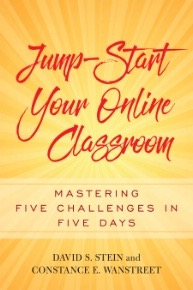classroom management
Select an item by clicking its checkbox
Growing up, one of my all-time favorite TV cartoons was Quickdraw McGraw and his faithful companion, Babalooi (does that date me?). Do you remember it? Quickdraw was the noble but naive, quick-on-the-trigger sheriff who fought off wicked desperados who inevitably found their way into his small, quiet prairie town. Sheriff ...

Control is Not a Four-Letter Word!: Establishing Positive Classroom Behavior for the Year in the First Five Days
Date Reviewed: January 23, 2019
Control is Not a Four Letter Word provides an abundance of helpful information for everyone from the first-time teacher to the veteran teacher. After forty years of classroom experience, Sarah Clancy-Ballard bridges the gap between learning how to teach and establishing classroom authority. She believes a teacher sets the tone for the entire year in the first five days of a new school year (xii). The resonating theme of the text is that classroom control emerges from preparation and “the depth of commitment the teacher has to control the class” (xiii). The author examines the importance of first impressions, organizing and utilizing the written word, time management, and behavior management.
Clancy-Ballard’s classroom teaching experience leads her to believe the secret to classroom management is a teacher’s ability to control their classroom when students feel that the teacher cares for them on a personal level (6). The author notes facial expression and remembering student names are the most important things a teacher can to do to set the tone and communicate interest in students as individual people. She values relationship building both inside and outside of the classroom as a vital part of a teacher’s educational philosophy. Clancy-Ballard stresses that teachers need to form relationships with janitorial staff, fellow teachers, and administrative staff, and encourages new teachers to watch “veteran teachers: what works and does not, and how it changes with each principal” (33). She provides a detailed look at how to organize the classroom space, utilize textbooks, handouts, and instructional boards, and create a daily classroom routine. The book covers dozens of examples of routine-driven agendas, inspiring readers to “establish a routine for the beginning of class” (46).
Clancy-Ballard equips the reader with clear guidelines for implementing evaluation methods and time management within the classroom. She associates teacher time management and student assessment to classroom behavior management, pointing once again to the importance of preparation. The author emphasizes that “the student’s attitude about himself or herself and you is directly related to how he or she perceives they are doing in class,” thus connecting the teacher’s behavior to the student’s achievements (55). She encourages teachers to take inventory of their strengths and weaknesses, understanding how their “behavior in class will directly impact the behavior” of their students (66). Clancy-Ballard proposes a benevolent dictatorship approach in the classroom – treating students as intelligent individuals who have ownership of classroom management. By beginning the school year with clear expectations and explaining why the guidelines are instrumental to the class’s success, the teacher can establish control through preparation characterized by benevolent dictatorship (71).
Control is Not a Four Letter Word is primarily written for first-time elementary school teachers; however, it can be a useful reference guide for teachers from elementary through high school. This book is a useful asset for school principals to utilize with teachers for discussion about the numerous reflection questions. This could help ensure appropriate application rises from knowledge.
Professors at the undergraduate level, will find Control is Not a Four Letter Word a helpful tool to assist senior-level students as they leave the classroom and begin student teaching. During the first half of the school year, student teachers would benefit by using the text’s key concepts to observe and evaluate the lead teacher and their level of classroom control. By the second half of the year, student teachers would be well versed in the key concepts, and thus prepared to apply Sarah Clancy-Ballard’s methods in the classroom.
“Spiritual Companioning for Ministry” is a course I recently taught for the first time for a colleague when she took a well-deserved sabbatical. She shared her syllabus and course plan with me and told me that she usually taught it to about 12 students which worked well for the topic. A ...
How do theological educators help students face the constant reality of failure? Picture this scenario: a second career divinity student suffers health and financial troubles that impede her studies. The impact of these issues revives past psychological wounds. Enduring this morass of difficulties leads to the student’s failure in ...

Jump-Start Your Online Classroom: Mastering Five Challenges in Five Days
Date Reviewed: April 2, 2018
As a twenty-plus year veteran professor in a face-to-face classroom environment, I know to expect adjustments due to technological advances. These adjustments typically include learning to use new technologies and including them in your established and comfortable pedagogical practices. These adjustments are additions to your teaching norm. Now, with entire programs being converted to online interface, the norm shifts continually. With shifting norms in mind, I chose to review this book and actually apply its approach while converting one of my own classes to online delivery.
The brevity of Jump-Start Your Online Classroom should not be underestimated. Based on practical application of the content and concepts, its organization contains helpful hints on various aspects of successfully constructing a learner-centered, virtual classroom experience. The organization of the book is its greatest strength. Its five-day approach is based on five challenges: (1) Making the transition to online teaching, (2) Building online spaces for learning, (3) Preparing students for online learning, (4) Managing and facilitating the online classroom, and (5) Assessing learner outcomes.
One to three chapters are devoted to each of the five tasks and guide in confronting, conquering, and mastering each challenge. Embedded in the chapters are the almost clairvoyant voices of novice online instructors as well as online learners. Additionally, each chapter includes highlighted “Points to Remember” and ends with a section “For Reflection.” This reflection portion, if done in depth, makes the five-consecutive-day plan less realistic. The reflections may include assignments such as developing a communication or time management plan, an assessment of technology tools, or a careful consideration of your own teaching philosophy or pedagogical approach.
The fourth challenge, on classroom management, was especially helpful, as it contemplates interpersonal interaction and community building with people that may never meet. The section on teaching presence was especially helpful and thought-provoking. The authors use the analogy of the working parts of a car. For example, teaching presence is described as the “transmission component that allows us to set the pace, sequence, and activities that support and encourage students to work with materials and build their understanding of the content,” and also as the “timing belt that helps us manage learners, the dialogue, and the conditions for learning” (78). I understood those analogous functions even though I could not pick out either of those parts on an actual car! Challenge four also looks at dealing with group work and disgruntled students. The perspective of the novice online instructor underscored the importance of modeling the behavior that is required of the students.
Although this book is marketed toward the novice online instructor, its approach, organization, and content make it a foundational tool that could have long-term value in troubleshooting and future course design.


